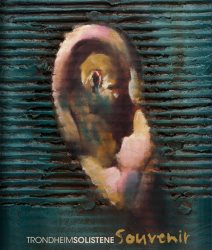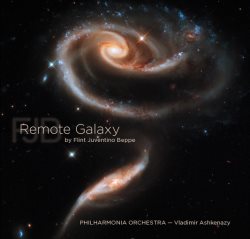| 

|
Souvenir
Pyotr Ilyich TCHAIKOVSKY (1840-1893)
Serenade for Strings , Op. 48
I. Pezzo in forma di Sonatina [9:22]
II. Walzer [3:59]
III. Élégie [8:42]
IV. Finale (Tema Russo) [7:44]
Carl NIELSEN (1865-1931)
Suite for String Orchestra, Op. 1
I. Prelude [3:09]
II. Intermezzo [5:31]
III. Finale [6:47]
Pyotr Ilyich TCHAIKOVSKY
Souvenir de Florence, Op. 70
I. Allegro con spirito [11:12]
II. Adagio cantabile e con moto [10:11]
III. Allegretto moderato [6:27]
IV. Allegro vivace [7:31]
Carl NIELSEN
Ved en Ung Kunstners Baare, FS.58 [4:42]
Trondheim Solistene
rec. May and October 2011, Selbu Church, Norway
Pure Audio Blu-ray (24/192 dts-HD Master Audio 5.1; 24/96 dts-HD Master
Audio 7.1; 24/96 Auro-3D 9.1; 24/192 PCM stereo). Downloadable mp3, wav,
24/96 and 24/192 flac files, cover art and booklet
2L-090-PABD BD-A [85:17]
Remote Galaxy
Flint Juventino BEPPE (b. 1973)
Remote Galaxy, Op.81* [18:34]
Distant Words, Op.43b**
I. Typhoon at Heart [10:23]
II. Healed by Red Wind [5:38]
Lost in September, Op.17 [9:12]
Tightrope walking beneath heaven, Op. 32 No. 8 [3:51]
Flute Concerto No. 2, Op. 80
I. Alarm [7:10]
II. Deepest Woods [5:31]
III. Escaping Time Power [5:29]
IV. Mrala [5:01]
*Ralph Rousseau (viola da gamba)
**Mark van de Wiel (clarinet)
***Emily Beynon (flute)
Philharmonia Orchestra/Vladimir Ashkenazy
rec. May 2012, Watford Colosseum, UK
Pure Audio Blu-ray (24/192 dts-HD Master Audio 5.1; 24/96 dts-HD Master Audio 7.1; 24/96 Auro-3D 9.1; 24/96 PCM stereo). Downloadable mp3, wav and 24/96 flac files, booklet & cover art
2L-100-PABD BD-A [82:00]
In my first 2L BD-A review
I began with an irreverent reference to a holiday on Mars, so it seems
appropriate that my second should include a disc entitled Remote
Galaxy. Those who have been following the Blu-ray Audio debate
on these pages will know that Norway’s 2L are leaders in this
new technology. Apart from their dedication to superior sonics –
which begins with unusual microphone placement and instrumental layouts,
diagrams of which are given in the booklets – they cater for
listeners of all stripes. For instance, their BD-As offer a number
of audio options, plus downloadable music files, the latter easily
accessible via a clever piece of software called mShuttle.
2L’s Morten Lindberg makes no apologies for promoting multi-channel,
as he considers stereo to be‘one-dimensional’. That’s
why the surround audio choices on these BD-As are so extensive, including
a 9.1 mix called Auro-3D, which attempts to locate music vertically
as well as horizontally. It appears a special decoder is required
for the latter, but that’s likely to appeal to only the most
dedicated audiophiles with deep pockets and large listening rooms.
These advances are fascinating, and Lindberg writes with infectious
enthusiasm about his quest for top-notch sound.
A quick perusal of my earlier review will confirm just how good the
sonics of these BD-As really are, even if – like me –
you listen in stereo. Their recordings, taken from high-res DXD masters,
have a tonal accuracy and three-dimensionality that’s just astonishing.
That’s true even when compared with high-res carriers such as
SACD; indeed, earlier 2L releases included a Super Audio disc as well
as a BD-A, so comparisons are quick and easy. That said listeners
need to recalibrate their antennae as it were, for the extreme clarity
of a BD-A will come as a rude shock after the relative warmth of an
SACD.
By offering so many options 2L are embracing the widest possible market; that sets them apart from the purveyors of more basic BD-As. In a truly multimedia environment – which even encompasses vinyl – that’s the only way to go; anyone who’s even vaguely aware of audio advances such as high-quality streaming, multi-channel downloads and DSD-capable DACs, will surely agree. However, that’s only part of the audio equation; what listeners want is a marriage of technology and good music-making, and that isn’t always a given.
I am also slightly concerned that those of us who listen in stereo
- and we are still in the majority - could be marginalised as the
emphasis switches to multi-channel. Indeed, I’ve just reviewed
an SACD of music for brass and organ that confirms my worst fears;
in surround the disc is considered a knock-out, but in stereo it’s
very disappointing. Given that Lindberg and other leading proponents
of BD-A see home cinema set-ups as a gateway to high-res audio it
is a source of some comfort that stereo is still a key part of the
package.
It’s all about maximum flexibility, and that’s why 2L’s
BD-As are such a good buy; I can make use of the disc and the 24/96
flacs, and if I choose to upgrade my DAC I will be able to play the
24/192 flacs as well. I must confess, though, that I can’t work
up much enthusiasm for the latter, as any sonic improvements over
24/96 are so small as to be negligible. In time I imagine 2L and their
partners will start to offer multi-channel downloads on their BD-As
as well, extending the listener’s choice even further.
Enough of the tech chat, what about the music? Trondheim Solistene
are a fine Norwegian ensemble whose recordings for BIS and 2L have
garnered much praise in the past. The repertoire on Souvenir
isn’t particularly adventurous, but at least it’s more
mainstream than some of 2L’s other obscure releases. Seconds
into Tchaikovsky’s Serenade for Strings it’s
clear that the fidelity and impact of this recording is something
special. The ‘hear-through’ quality of the sound –
individual instruments are easily discerned, their timbres well preserved
– may be too forensic for some, but as I’ve suggested
before it’s all about retuning one’s ears.
Rarely has the physical presence of musicians been so keenly felt,
and that goes for both the PCM stereo mix and the 24/96 flacs. It’s
not just about timbres, as rhythms and dynamics are subtle and sophisticated
too; just listen to the urgent, full-toned pizzicati, especially
in the Finale (Tema Russo) and relish those lovely singing lines.
This is also a gorgeous performance, full of passion and bite, and
it leaves one energised and elated. The youthful Nielsen Suite
is even lovelier, and the trembling strings of the Prelude are incisive
but not over-bright; as for the lower strings the dark resonance of
these instruments is also superbly caught.
There’s a pleasing balance here between the technology and the music; it would be all too easy to aim for a ‘hi-fi spectacular’, but that’s not the way 2L operate; the music comes first, so that even as one delights in the open and effortless sound of the Intermezzo one also marvels at the dancing delicacy of this early opus. In the vigorous Finale the basses’ firm, well-rounded contributions give the music such stability and shape. Initially I felt the upper strings were a tad fierce, but one only has to hear this music live to realise that’s exactly how they sound when played with such unanimity and strength.
The rest of this programme – it’s divided into two parts – is just as satisfying. The Souvenir de Florence is big and bold, and the recording’s fine detail makes the inner voices of the Allegro con spirito all the lovelier. It’s such an eventful and involving performance, and it’s all recorded at a decent level; indeed, I had to reduce my usual volume setting by some 5-6dB, and even then every fibre and strand of the music is clean and clear. The ardent mass and surge of the Nielsen piece is particularly well served by this forthright recording.
Souvenir is an unqualified success, and at no time did I
feel the stereo mix was compromised or downgraded. Sadly, I’m
less happy with Remote Galaxy, recorded in the Watford Colosseum.
My heart sank when I read the liner-notes, whose faux profundities
do little or nothing to illuminate the music. The Norwegian composer
Flint Juventino Beppe – previously known as Fred Jonny Berg
– is new to me, and the evocative work titles promise far more
than they actually deliver. The viola da gamba in the title piece
is interesting, if unremarkable, but I responded much more positively
to Mark van de Wiel’s characterful clarinet playing in Distant
Words.
Musically this is threadbare stuff, although Ashkenazy and the Philharmonia
make the most of what they’re given. As for the Flute Concerto
No. 2 it’s slight but pleasing; the solo part is well taken
by Emily Beynon. The sound is slightly less accomplished than I would
expect from this talented team, although the usual virtues –
immediacy and engagement – are pretty much intact. Not the kind
of programme that appeals to me, but I suspect it may beckon to those
who want something lighter and less demanding than the core repertoire
usually provides. The disc is supplied in an SACD-style super jewel
case rather than the usual Blu-ray box, which is a little confusing.
One hit, one miss; first-class presentation though.
Dan Morgan
http://twitter.com/mahlerei
 |
 |
|
